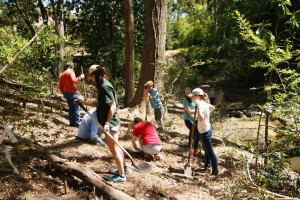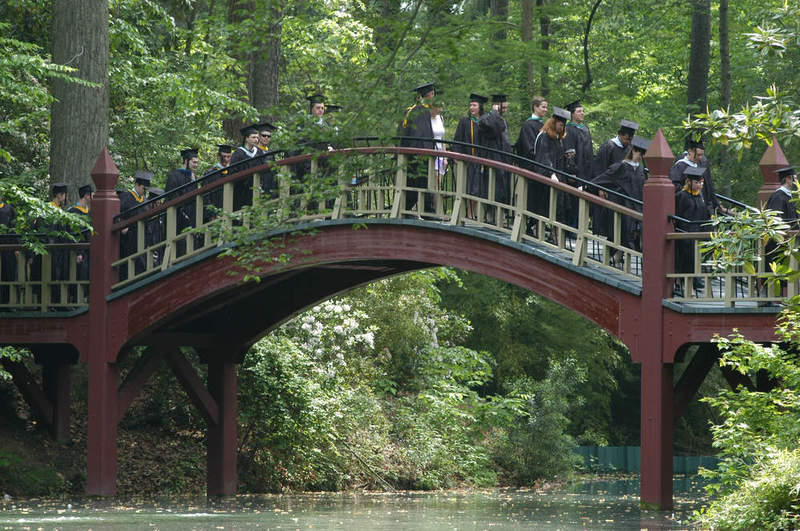Fifty years ago, a plain wooden bridge stood over a small pond, then called Landrum pond, behind the Sunken Garden. In 1966, the College of William and Mary replaced the rustic landmark with an Chinese style bridge, and renamed the area as the Crim Dell. This pond quickly became one of the most iconic spots on campus, and students are currently trying to restore the Crim Dell to its former glory.
The Crim Dell gets its name from John Crim, who graduated in 1901. Private funds from the Crim family, the senior class gift of 1964 and a friend to the College named David Baer paid for the construction of the bridge and the development of the surrounding area.
According to an article written in the Dec. 1, 1995 issue of the William and Mary News, Davis Paschall said that the bridge was built using an Asian-inspired architectural style because of the importance of trade with China to Williamsburg during the colonial period. Paschall served as president of the College during the bridge’s construction.
The College also renovated the area surrounding the bridge. Trails were constructed so that students could walk and admire the scenery. New plants such as azaleas, camellia, dogwood, magnolia, weeping cherry and mountain laurel added to the greenery.
“We think it has a lot of potential and we want to see it live up to its potential,” May said.
The College dedicated the bridge in 1966 during the first annual Parent’s Day — now called Family Weekend.
“Here one may walk in beauty, discover the serenity of the quiet moment, and dispel the shadows,” a plaque attributed to Paschall said.
There are now different traditions and myths surrounding the Crim Dell. Swimming in the Crim Dell is one of the three activities in the College triathlon. Student lore holds that if you and your partner cross the bridge together, you are destined to be together forever, and the only way to reverse this fate is to throw your partner into the pond from the middle of the bridge. Walk across the bridge alone, however, and you’ll be fated to spend the rest of your life in solitude.
Although the landscape surrounding the Crim Dell has changed since it was built, it remains a campus landmark.
“It’s like an island of green in the surrounding campus, so it’s really nice,” Richie Thaxton ’16, one of the volunteers helping restore the Crim Dell, said.
It isn’t necessary to cross the bridge in order to enjoy the scenery. Students frequently cut through the surrounding trails on their way to class.
“I have a class on Tuesdays and Thursdays that’s in Andrews, and then I have a class ten minutes later in Tucker, so I always cut through the Crim Dell,” Kendall King ’19, another volunteer, said. “I think it’s just the spring — seeing everything blooming, it’s really pretty. It’s a really nice walk.”
The Crim Dell isn’t the same pond it was back in 1966. The trails are a little worse for wear, and the landscape isn’t what it used to be. Invasive plant species have taken over much of the area.
The Student Environmental Action Coalition began the restoration project last spring semester. The idea came from Nick Newberry ’17, who is currently studying abroad, and led to the creation of the Restoration Campaign in SEAC. Jesse Smyth ’18 and Carolina May ’18 are now in charge of the project. Once or twice a semester, the campaign hosts a work day where all students are welcome to come help restore the Crim Dell.

May said the campaign broke down its goals for the restoration into three areas.
“The first was ecological sustainability,” May said. “We’re interested in making sure the native plants can thrive, replanting native plants, getting rid of invasive species that are really overtaking the native plants.”
Some examples of invasive species include English ivy and bamboo. Volunteers who went to help with the cleanup Sunday, April 17 spent hours pulling out bamboo on the north slope of the southern part of the Crim Dell.
May and Smyth said they also want to make the Crim Dell more accessible to students. They plan on fixing the trails so they are less hazardous to students. Smyth said they also wish to partner with Health Outreach Peer Educators, a mental and sexual welness group, to create a mental health sanctuary by the Crim Dell.
Another goal of the restoration project is to increase the overall aesthetic value of the Crim Dell. One simple objective is to clean up the litter in the area. This past Sunday, volunteers found a rusting folding chair.
Smyth and May consult with their project coordinator Linda Morse and other science faculty, but students complete much of the work and decision-making. Student volunteers have already removed some of the invasive species and planted about 90 new native plants, according to Smyth.
The restoration project was also recently awarded a Green Fee. Green Fees fund projects proposals chosen by the College’s Committee on Sustainability that advance the President’s Policy on Sustainability. The project was also awarded a Green Fee last year.
Members of the restoration committee will be meeting in the upcoming weeks to decide how they will use the money and what they can begin working on in the fall. Both Smyth and May hope they can plan work days early in the fall in order to get work done before students are busy with classes.
“We think it has a lot of potential and we want to see it live up to its potential,” May said.


Good job people! Though you may need to expand your thinking on what plants are suitable. Whenever it was first laid out, the landscapers used whatever plants were commercially available. This doesn’t necessarily convey any stamp of appropriateness or authenticity…it was just expedient. I would work with what is there, organize the plantings maybe, prune!!!, select, and by all means consult with local nurserymen and contemporary landscape architects. But by all means , keep up the good work! Your hearts are in the right place.